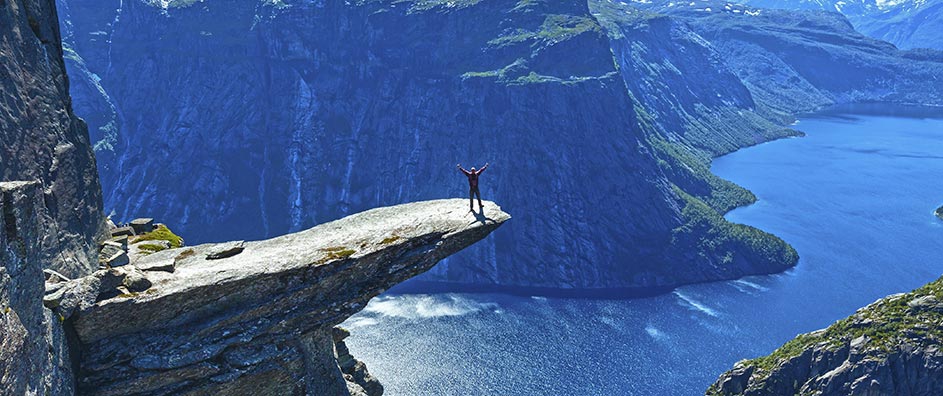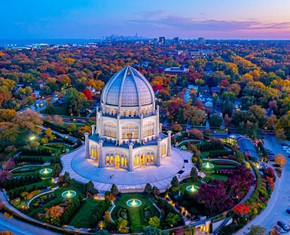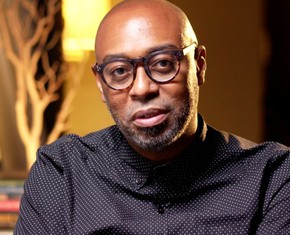The views expressed in our content reflect individual perspectives and do not represent the authoritative views of the Baha'i Faith.
I’ll end this series of essays about hell with a little story about heaven.
A few years ago my wife and I visited Scandinavia, the beautiful land of our Viking ancestors.(As a Swede, she swears that only my Norwegian ancestors were marauding Vikings, and that her progenitors were all neutral and peaceful people. Hah!)
Anyway, we happily drove through Norway (and Sweden), visited the fjords and marveled at the pristine wonder of the countryside. To us this gorgeous landscape seemed somehow genetically familiar, even though we’d never physically been there before. Both of us loved the rugged mountainsides as they sloped down into the sea; the little-changed, charming fishing villages that my ancestors lived and worked in; the wide swath of the North Sea off the wild coast; the sense of untamed magic and myth we could feel in the forests and peaks. In Norway you can understand exactly how those fanciful ancient Norse myths came about. It’s easy to picture Odin hurling thunderbolts down from the mountaintops and imagine a bustling Valhalla somewhere in the clouds.
We visited my long-lost relatives, heard the old stories and songs, discovered my great-grandfather’s original homestead and had a wonderful time. If you’ve never returned to your ancestral lands, I recommend it highly.
Anyway, among many other things, I wanted to see a stave church in Norway. My grandfather Olaf was a master carpenter, and he told me tales of these churches, constructed by true craftsman using only hand tools and joinery and no nails in the traditional way, and built so well they lasted a thousand years.

So we went to a place in Norway’s Vang municipality called Ryfoss, and we came upon the towering Høre Stavkyrkje, otherwise known as the Høre stave church. Originally built in 1180 during the period when Scandinavia had begun to transition from its ancient religious practices to Christianity, the craftsmanship of the church was absolutely stunning—but I learned something about heaven and hell there that I didn’t expect to find.
The first thing we discovered, thanks to a knowledgeable guide: the church represented that exact time period when that area had converted to Christianity. Above the altar, you can still see a carved Christ on a crucifix. But next to that figure, you’ll see dragons. The Norse Gods are represented, too, Odin and Thor and Freya. Here, I realized, was a historical monument of the coming of a Prophet of God to a people, and a record of their response to that call.
I asked questions about the restoration, and our guide said only the floor had been replaced—sure enough, just as my grandfather had said, the walls and the roof had been there since the church was built, which amazed me. Then I got curious, and asked what they found under the old floor when they replaced it.
“We found lots of old Viking coins,” he said, “offerings that must have fallen through the cracks of the floorboards.”
“Anything else?” I asked, sensing that he was holding something back. The guide’s happy expression changed, and in a reverent whisper he told us that they had found a large number of graves under the church, including the swaddled skeletons of many newborn infants.
What?! How strange. Newborn infants, buried under the church? We didn’t understand.
Well, our guide said, during those days a burial plot in the church cemetery was probably expensive, and the peasants in the village couldn’t afford such a luxury. Also, in those pre-medical days and in that remote place, many infants died in childbirth, some with their mothers. So, the guide told us, the grieving survivors crawled under the church and buried their children there, probably during the dark of night, with the small hope that the babies’ proximity to a source of spiritual grace might save their souls.
At that moment I realized, as if Odin had hit me with one of his thunderbolts, that those newly-Christian old Norse inhabitants, my Viking ancestors, the same mighty, fearsome warriors and pirates and plunderers who had violently conquered much of the known world, had found a spiritual existence when they built their stave churches. In accepting Christ, they had gradually come to believe in a heaven, in immortality, in a life after this one. And those beliefs, along with the love and peace that exemplify all of the teachings of the great world religions, eventually convinced the Vikings to cease their warlike ways.
Good thing, or we’d probably all be speaking Viking.
Go to Stockholm or Oslo and you’ll see the results of that process. The Scandinavian countries have the most well-preserved cities in all of Europe. Why? Because they haven’t had wars in hundreds of years. Their cultures, peaceful and neutral and conciliatory, have become some of the most prosperous and advanced on Earth.
All because of heaven:
For a single purpose were the Prophets, each and all, sent down to earth; for this was Christ made manifest, for this did Baha’u’llah raise up the call of the Lord: that the world of man should become the world of God, this nether realm the Kingdom, this darkness light, this satanic wickedness all the virtues of heaven — and unity, fellowship and love be won for the whole human race, that the organic unity should reappear and the bases of discord be destroyed and life everlasting and grace everlasting become the harvest of mankind. – Abdu’l-Baha, Selections from the Writings of Abdu’l-Baha, p. 30.
















Comments
Sign in or create an account
Continue with Googleor